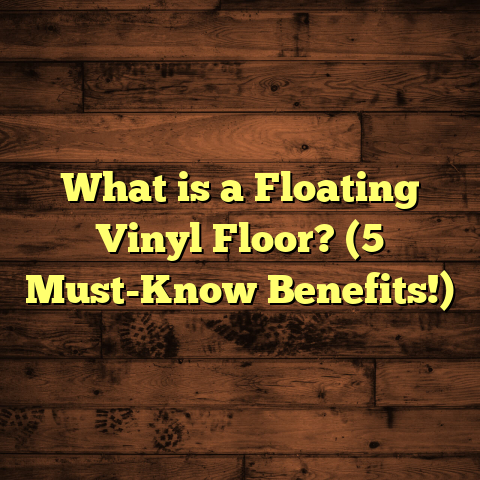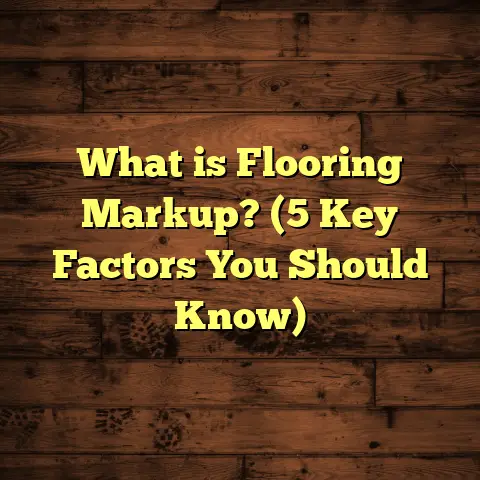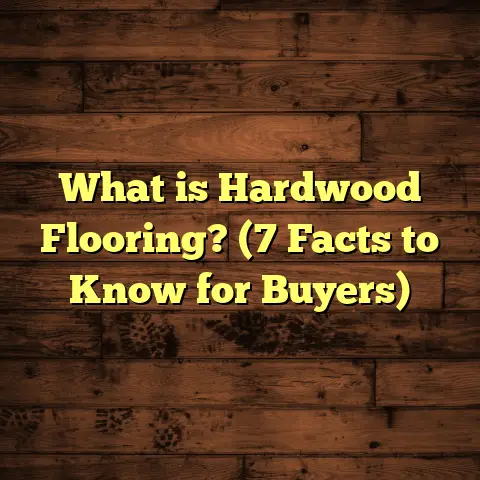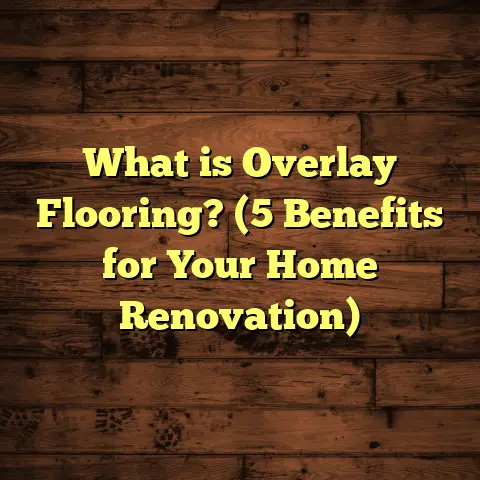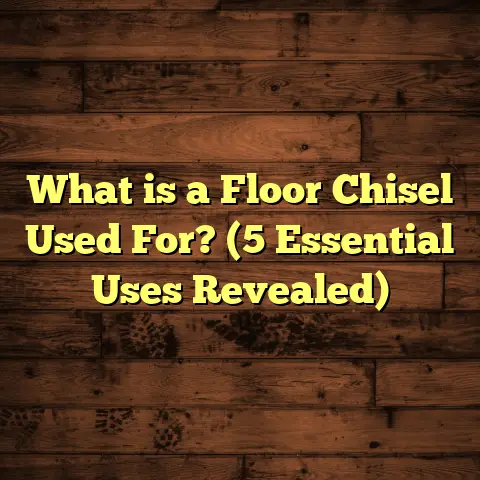What is Luxury Floating Vinyl Flooring? (5 Benefits You Must Know)
Bold Designs and Flooring Choices: Why Luxury Floating Vinyl Flooring?
When I think about bold home designs, the flooring is the foundation that sets the mood for everything else. You might have vibrant walls or statement furniture pieces, but if the floor isn’t right, the entire space feels off. Over the years, I’ve worked on countless flooring projects, and one option that consistently impresses me—and my clients—is luxury floating vinyl flooring. It’s a beautiful blend of style, durability, and practicality that suits modern lifestyles perfectly.
You might be asking yourself: what exactly is luxury floating vinyl flooring? How does it compare to other flooring options? What benefits can it bring to my home or business? Let me walk you through what I’ve learned from hands-on experience, research, and a few memorable projects.
What is Luxury Floating Vinyl Flooring?
Luxury floating vinyl flooring (LVP) is a high-end type of vinyl floor designed to mimic the look and feel of natural materials like hardwood or stone but with added benefits. Unlike traditional vinyl sheets glued directly to the subfloor, LVP consists of individual planks or tiles that click together and “float” over an underlayment without being glued or nailed down.
The “luxury” part means these floors come with enhanced features such as thicker wear layers for improved durability, realistic textures that feel natural underfoot, and often waterproof cores. These planks can be rigid (Stone Plastic Composite – SPC) or slightly more flexible (Wood Plastic Composite – WPC), giving you options depending on your needs.
Understanding the Layers of Luxury Vinyl Planks
Each plank is made up of several layers:
- Wear Layer: This transparent top layer protects against scratches, stains, and scuffs. The thicker it is (usually measured in mils), the more durable it tends to be.
- Design Layer: This is a printed image of wood grain, stone texture, or other patterns. Thanks to advanced printing technology and embossing, these designs are incredibly realistic.
- Core Layer: This provides structural stability. SPC cores are denser and harder, making them great for commercial or high-traffic areas. WPC cores have a softer feel and offer better sound insulation.
- Backing Layer: Sometimes includes an attached underlayment to provide cushioning and sound dampening.
Imagine walking barefoot on a floor so realistic you can feel the grain of “wood,” but it’s waterproof and resistant to dents. That’s what luxury floating vinyl flooring offers.
Why I Recommend Luxury Floating Vinyl Flooring: 5 Benefits You Must Know
1. Easy Installation — Saving Time and Money
One of the biggest advantages I’ve noticed with luxury floating vinyl flooring is how straightforward it is to install. The click-lock system means you don’t need glue or nails, which speeds up the process significantly.
I remember working on a kitchen remodel where we installed 800 square feet of LVP in under three days. The homeowner was thrilled because this helped us meet tight deadlines without cutting corners on quality.
If you’re a DIY enthusiast, this flooring is very approachable—you can usually install it over existing floors as long as the surface is flat and clean. This reduces prep time and costs compared to removing old flooring.
Professional installers also appreciate this efficiency since they can take on more jobs in less time while maintaining a high standard.
2. Water Resistance — Use It Anywhere in Your Home
I’ve seen many homeowners hesitate when choosing between laminate or hardwood because of moisture concerns—especially for bathrooms, kitchens, or basements. Luxury vinyl flooring solves those worries.
Many LVP options come fully waterproof thanks to their core materials and tight locking mechanisms that prevent water seepage between planks. This means spills, pet accidents, or even minor flooding won’t ruin your floor.
A personal story: A client I worked with had their basement flood after heavy rains. They had installed LVP just months earlier. When I visited afterward, their floor was bone dry with no signs of swelling or damage—a relief compared to their previous carpeted floor that was ruined.
3. Realistic Looks Without Breaking the Bank
You might love the idea of hardwood floors but be put off by their cost or maintenance demands. Luxury vinyl flooring replicates wood grains and stone patterns so well that many people can’t tell the difference visually.
Pricing for LVP is typically 30-60% lower than hardwood floors. For example:
| Flooring Type | Approximate Cost / Sq Ft (Material + Installation) |
|---|---|
| Hardwood (Oak) | $8 – $12 |
| Laminate | $3 – $7 |
| Luxury Vinyl Plank | $2.50 – $6 |
| Tile (Ceramic/Porcelain) | $5 – $10 |
This price difference lets homeowners achieve upscale looks while staying within budget.
I often recommend LVP for clients wanting a modern or rustic aesthetic without the hassle of refinishing or worrying about scratches from pets or kids.
4. Comfort and Noise Reduction
If you live in a busy household or work in an office setting, noise control is a big deal. Unlike hard tile or hardwood floors that can echo footsteps loudly, luxury floating vinyl flooring often includes an underlayment or allows one to be added.
This cushioning effect makes walking more comfortable and reduces sound transfer between floors. In apartment buildings where noise complaints are common, this can be a lifesaver.
In daycare centers where I’ve installed LVP, staff noted how much quieter the environment became compared to linoleum or laminate floors.
5. Low Maintenance — Perfect for Busy Lives
When you have kids running around or pets tracking dirt inside, easy-to-clean floors become a priority. One reason I love luxury floating vinyl flooring is how simple it is to maintain.
Sweeping regularly and occasional damp mopping usually keeps it looking fresh. Stains wipe away easily thanks to the protective wear layer.
A study from the National Floor Safety Institute found that LVP surfaces scored high for slip resistance even when wet—making them safer around kids and elderly family members.
Going Beyond Benefits: What You Should Know Before Buying
Picking Between SPC and WPC
When shopping around for luxury vinyl flooring, you’ll encounter two main types of core materials: SPC (Stone Plastic Composite) and WPC (Wood Plastic Composite).
- SPC: Denser and harder; better suited for commercial spaces or high-traffic areas.
- WPC: Softer and more cushioned; ideal for residential spaces needing comfort underfoot.
On one commercial project I consulted on—a busy cafe—SPC was chosen because it could handle heavy foot traffic without denting or cracking over time.
If you want warmth and softness in bedrooms or living rooms, WPC might be more your style.
Thickness Matters
The overall thickness of LVP varies from about 4mm to 8mm or more. Thicker products tend to feel sturdier and may include pre-attached underlayment for extra comfort.
In my experience installing thinner options (around 4mm) in rental properties works well because they are budget-friendly but still durable enough for moderate use.
For families investing in their forever home, thicker planks provide a more luxurious feel and longer lifespan.
Color and Texture Choices
Luxury vinyl flooring comes in an enormous range of colors and textures—from weathered gray woods to glossy marble looks. A common mistake I see people make is choosing trendy colors without considering long-term appeal.
Think about your room’s lighting, furniture style, and how often you may want to change decor before picking bold colors.
I once had a client who chose a deep mahogany tone for their living room floor; it looked stunning but made the space feel darker than expected. We balanced that later with lighter walls and modern furnishings.
Environmental Considerations
Some manufacturers now offer eco-friendly vinyl flooring made with recycled materials and low-VOC adhesives to reduce indoor air pollution.
If sustainability matters to you, ask suppliers about certifications like FloorScore or GREENGUARD Gold when shopping for LVP products.
Installation Insights: What I’ve Learned on the Job
Installing luxury floating vinyl flooring seems straightforward but requires attention to detail for best results. Here are some tips from my years on site:
Preparing Your Subfloor Is Key
Even though floating floors can hide minor imperfections, large bumps or dips cause issues down the line like gaps or uneven wear.
Make sure your subfloor is clean, dry, level within 3/16 inch over 10 feet (industry standard), and free from debris before installation starts.
Acclimate Your Flooring First
Leave your planks in the room where they will be installed for at least 48 hours before laying them down. This helps prevent expansion or contraction due to temperature changes after installation.
Once on site during one cold winter project, skipping this step led to noticeable gaps after a few weeks—something easily avoidable with acclimation.
Leave Proper Expansion Gaps
Because vinyl expands slightly with heat changes, leave a small gap (usually around 1/4 inch) around walls and fixtures. Use baseboards or quarter rounds later to cover these gaps neatly.
Missing this step can cause buckling or warping over time.
Use Quality Tools
I recommend using a tapping block and pull bar specifically designed for LVP installation rather than household tools like hammers or screwdrivers to avoid damaging plank edges during fitting.
Don’t Rush Cutting Planks
Accurate cuts ensure tight seams and professional appearance. Use a sharp utility knife for straight cuts on vinyl planks rather than saws when possible—this reduces dust and mess.
Maintenance Tips That Keep Floors Looking New
Once your beautiful luxury floating vinyl floor is down, keeping it pristine requires minimal effort but some care:
Daily Cleaning
Sweep or vacuum regularly to remove grit that can scratch surfaces over time.
Avoid vacuums with rotating brushes that may damage wear layers; instead use soft brush attachments.
Wet Cleaning
Use a damp mop with water or manufacturer-recommended cleaners specifically designed for vinyl floors.
Avoid harsh chemicals like bleach or abrasive cleaners—they break down protective layers accelerating wear.
Protect High-Traffic Areas
Place rugs at entrances and under furniture legs to reduce dirt buildup and indentations.
Use felt pads under chairs and tables to prevent scratches when moving furniture around.
Addressing Scratches and Scuffs
Minor scratches often disappear after several cleanings due to wear layer properties; deeper ones might require repair kits available from manufacturers or professional restoration services.
From my experience helping clients fix pets’ claw marks, quick cleaning combined with protective mats greatly reduces damage risk.
Common Questions I Hear About Luxury Floating Vinyl Flooring
How Long Does It Last?
When properly installed and maintained, luxury vinyl flooring can last between 15-20 years according to industry data. Some brands offer warranties up to 25 years depending on wear layer thickness.
Can It Be Refinished?
Unlike hardwood floors, LVP cannot be sanded down and refinished. If damaged beyond repair, you replace individual planks without removing the entire floor—one advantage over hardwood’s costly refinishing process.
Is It Safe for Kids?
Yes! LVP is non-toxic when made with low-VOC materials. Its water resistance helps prevent mold growth underneath—which benefits allergy sufferers too.
Can It Be Installed Over Radiant Heat?
Some luxury vinyl products are compatible with radiant heating systems but always check manufacturer specs before installation because excessive heat can damage certain cores or adhesives.
Case Study: Transforming a Family Home with Luxury Floating Vinyl Flooring
Let me share a detailed example from my own portfolio:
The Johnson family wanted durable yet stylish flooring throughout their main living areas including kitchen, hallway, dining room, and basement playroom. They had young kids and pets plus frequent guests visiting.
We chose a 6mm thick SPC core plank with 20 mil wear layer featuring oak wood visuals with natural grain embossing—a great balance of beauty and toughness.
Installation took four days total:
- Day 1: Subfloor prep including leveling minor dips.
- Day 2-3: Installing planks across all rooms.
- Day 4: Finishing trims and baseboards plus cleaning up debris.
Post-installation feedback was glowing:
- They loved how seamless the transitions looked between kitchen tile area and living spaces.
- Spill clean-up became effortless; no more worrying about water damage.
- The floor reduced noise levels noticeably during kids’ playtime.
- Their guests complimented how natural the wood pattern looked compared to real hardwood floors they’d seen elsewhere.
- Maintenance effort dropped significantly compared to their previous carpeted basement playroom where stains were constant headaches.
This project reinforced why I recommend luxury floating vinyl flooring so often—it fits busy family needs beautifully without sacrificing style.
Comparing Luxury Floating Vinyl Flooring With Other Popular Options
| Feature | Luxury Floating Vinyl | Hardwood | Laminate | Tile | Carpet |
|---|---|---|---|---|---|
| Installation | Easy click-lock floating | Nails/glue needed | Click-lock floating | Mortar & grout | Staple/glue |
| Water Resistance | Waterproof options available | Sensitive to moisture | Sensitive | Waterproof | Not waterproof |
| Durability | High | High but dents possible | Moderate | Very high | Low |
| Comfort | Good (with underlayment) | Moderate | Moderate | Hard | Very comfortable |
| Maintenance | Low maintenance | Requires refinishing | Low maintenance | Low | High (vacuuming) |
| Cost | Moderate | High | Low | Moderate-high | Low |
| Realism/Appearance | Very realistic wood/stone | Natural beauty | Less realistic | Authentic tile | Variety in textures |
Final Thoughts
Throughout my career installing and advising on flooring choices, luxury floating vinyl flooring stands out as a remarkably adaptable solution that blends aesthetics with practical benefits. Whether you’re updating a rental unit on a budget or crafting your dream home’s interior design, its durability, ease of care, waterproof nature, comfort level, and affordability make it an excellent pick worth serious consideration.
If you want bold design without sacrificing function — this might just be your new favorite floor!
If you want me to help calculate costs using tools like FloorTally or guide you through specific product recommendations based on your space dimensions and lifestyle needs, just ask! I’m here to make your flooring journey smooth from start to finish.
